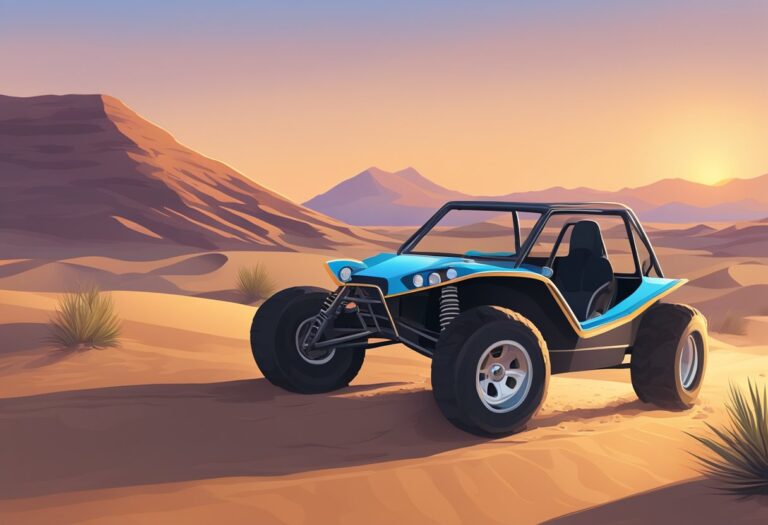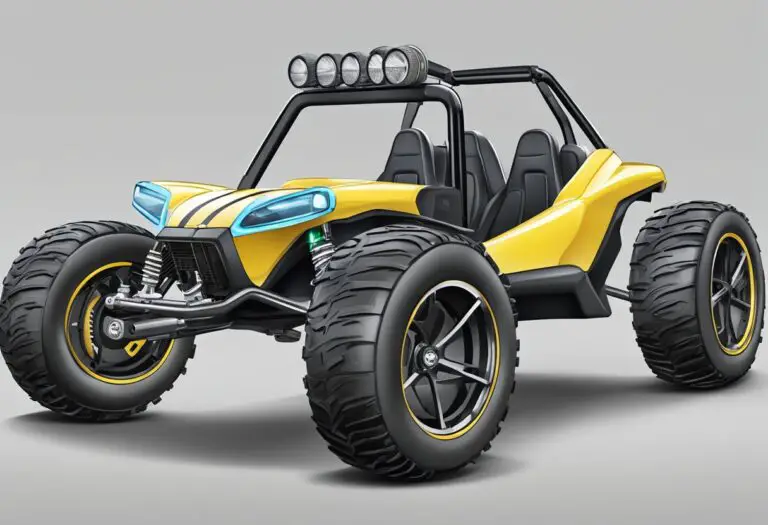How Much Does a Dune Buggy Weigh: A Comprehensive Guide
Dune buggies are off-road vehicles designed to travel on sand dunes, beaches, and deserts. These lightweight vehicles are known for their unique appearance and high-performance capabilities. One of the most important factors that determine the performance of a dune buggy is its weight. In this article, we will explore the topic of dune buggy weight and provide an overview of how much a dune buggy typically weighs.

Dune buggies come in different types and sizes, and their weight can vary significantly depending on their design, materials, and construction. Generally, a dune buggy can weigh anywhere from 500 to 2000 pounds, with an average weight of around 1000 pounds. The weight of a dune buggy is an important consideration for both performance and safety. A lighter dune buggy is generally faster and more maneuverable, but it may also be less stable and more prone to tipping over. On the other hand, a heavier dune buggy may be more stable and durable, but it may also be slower and less responsive.
The weight of a dune buggy is influenced by various factors, including the type of chassis, suspension, engine, and bodywork. In addition, the weight of a dune buggy can be affected by customization and modifications, such as adding accessories, changing tires, or upgrading the engine. It is important for dune buggy owners to understand the impact of weight on performance and safety and to take appropriate measures to manage the weight of their vehicle.
Key Takeaways
- Dune buggies can weigh anywhere from 500 to 2000 pounds, with an average weight of around 1000 pounds.
- The weight of a dune buggy is important for both performance and safety.
- The weight of a dune buggy is influenced by various factors, including the type of chassis, suspension, engine, and bodywork.
Dune Buggy Weight Overview

Average Weight Range
The weight of a dune buggy can vary greatly depending on various factors such as the type of engine, frame, and body used. On average, a dune buggy typically weighs between 800 and 1,300 pounds. However, this weight range can vary depending on the specific make and model of the dune buggy.
Factors Affecting Dune Buggy Weight
Several factors can affect the weight of a dune buggy. The following are some of the factors that can impact dune buggy weight:
- Engine Type: The type of engine used in a dune buggy can significantly affect its weight. For instance, a dune buggy with a lightweight engine, such as a four-cylinder engine, will weigh less than one with a heavier engine, such as a V6 or V8 engine.
- Frame Material: The material used to build the frame of a dune buggy can also impact its weight. Dune buggies with frames made of lightweight materials such as aluminum or carbon fiber tend to weigh less than those with frames made of heavier materials such as steel.
- Body Material: The material used to build the body of a dune buggy can also affect its weight. Fiberglass is a popular material for dune buggy bodies because it is lightweight and durable.
- Accessories: The weight of accessories such as seats, roll cages, and tires can also impact the weight of a dune buggy. For example, a dune buggy with heavy-duty off-road tires will weigh more than one with standard tires.
In conclusion, the weight of a dune buggy can vary greatly depending on several factors. It is essential to consider these factors when choosing a dune buggy to ensure that it meets your needs and requirements.
Weight by Dune Buggy Type

Dune buggies come in different shapes and sizes, and their weight can vary depending on the type of buggy. Here are some examples of lightweight and heavy-duty dune buggies.
Lightweight Models
Lightweight dune buggies typically weigh between 500-800 kg (1100-1760 lbs). These buggies are designed for speed and agility and are often used for racing or recreational purposes. They are usually made of fiberglass or aluminum, which makes them lightweight and easy to maneuver.
Some popular lightweight dune buggy models include the Meyers Manx, Berrien Nostalgia, and the Sand Rail. These buggies are known for their speed and handling, and they are often used in off-road competitions.
Heavy-Duty Models
Heavy-duty dune buggies are designed for rough terrain and heavy-duty work. These buggies are usually made of steel or iron, which makes them heavier but more durable. They are often used for industrial or commercial purposes, such as mining, construction, or transportation.
Some popular heavy-duty dune buggy models include the Joyner Sand Viper, the BMS Sand Sniper, and the Kandi Spider. These buggies are known for their power and durability, and they can handle rough terrain and heavy loads.
It’s important to note that the weight of a dune buggy can vary depending on the manufacturer, model, and modifications. Always check the manufacturer’s specifications for the exact weight of the buggy you are interested in.
Impact of Weight on Performance

Speed and Acceleration
The weight of a dune buggy can significantly impact its speed and acceleration. Generally, the lighter the dune buggy, the faster it can go and the quicker it can accelerate. This is because less weight means less force is required to move the vehicle, allowing for better power-to-weight ratios.
According to TheSamba.com, a manx style dune buggy with a VW engine weighed 1100 lbs. However, the weight distribution between the front and rear of the vehicle can also affect its speed and acceleration. A race-deZert forum post suggests that mounting components such as batteries, dry sump, spares, and fuel forward can help achieve a 70/30 weight distribution, which can improve acceleration and handling.
Handling and Stability
The weight of a dune buggy can also impact its handling and stability. A heavier dune buggy may have more stability due to a lower center of gravity, but it may also be more difficult to handle and maneuver. On the other hand, a lighter dune buggy may be more nimble and easier to handle, but it may also be more prone to tipping over.
To improve handling and stability, dune buggy enthusiasts may consider trimming the body to reduce weight. Fiberglass body kits are a popular option for dune buggies because they are lightweight and durable. However, it is important to ensure that the body can withstand impacts from rocks, trees, and other obstacles that may be encountered during off-road driving.
In summary, the weight of a dune buggy can have a significant impact on its performance. While a lighter dune buggy may be faster and easier to handle, a heavier dune buggy may have more stability. Dune buggy enthusiasts should consider the weight distribution and body trimming options to optimize their vehicle’s performance and handling.
Materials and Construction

When it comes to the weight of a dune buggy, the materials used in its construction are crucial factors. The frame and body materials can significantly affect the weight of the vehicle.
Frame Materials
The frame of a dune buggy can be made from various materials, including steel, aluminum, and chromoly. Steel is a common material used for the frame, as it is strong and durable. However, it can be heavy, which can add weight to the vehicle. Aluminum is a lightweight material that can help reduce the overall weight of the dune buggy. Chromoly is a combination of chromium and molybdenum, which makes it strong and lightweight.
Body Materials
The body of a dune buggy is usually made of fiberglass, which is a lightweight material that can be molded into various shapes. Fiberglass is durable and can withstand the harsh conditions of off-road driving. Additionally, it can be painted to give the dune buggy a unique look. Other materials that can be used for the body include carbon fiber and aluminum, which are also lightweight materials.
Overall, the materials used in the construction of a dune buggy can significantly impact its weight. While steel is strong and durable, it can add weight to the vehicle. On the other hand, aluminum and chromoly are lightweight materials that can help reduce the overall weight of the dune buggy. Similarly, fiberglass is a lightweight and durable material that is commonly used for the body of a dune buggy.
Customization and Modifications

Aftermarket Parts
Customization and modifications are an essential part of owning a dune buggy. Aftermarket parts can be used to improve the performance and appearance of the vehicle. Some of the most popular aftermarket parts for dune buggies include suspension kits, exhaust systems, and performance air filters.
Suspension kits can help to improve the handling and stability of the dune buggy. They are available in a variety of styles and can be adjusted to suit the terrain. Exhaust systems can help to increase the power of the engine and improve the sound of the vehicle. Performance air filters can help to improve the airflow to the engine, which can result in better performance and fuel efficiency.
Weight Reduction Techniques
Weight reduction techniques can be used to improve the performance of the dune buggy. By reducing the weight of the vehicle, the engine doesn’t have to work as hard to move the vehicle, which can result in better performance and fuel efficiency. Some popular weight reduction techniques include:
- Fiberglass body kits: Fiberglass is a lightweight and durable material that can be used to replace heavy metal body panels.
- Lightweight wheels: Lightweight wheels can reduce the amount of unsprung weight, which can improve the handling and acceleration of the dune buggy.
- Removing unnecessary components: Removing unnecessary components, such as air conditioning and power windows, can reduce the weight of the vehicle.
It is important to note that while weight reduction techniques can improve the performance of the dune buggy, they should be done carefully. Removing too much weight can negatively impact the handling and stability of the vehicle. It is recommended to consult with a professional before making any significant modifications to the dune buggy.
Regulations and Safety

Legal Weight Limits
Dune buggies are subject to weight limits set by state and federal regulations. These weight limits are in place to ensure the safety of the driver and other motorists on the road. The legal weight limit for a dune buggy varies depending on the state in which it is registered. For example, in California, the maximum weight limit for a dune buggy is 1,800 pounds, while in Florida, the maximum weight limit is 2,500 pounds.
It is important to note that exceeding the legal weight limit can result in fines and penalties. Additionally, an overweight dune buggy may be more difficult to control, increasing the risk of accidents.
Safety Considerations
In addition to weight limits, there are several safety considerations to keep in mind when operating a dune buggy. These considerations include:
- Seat belts: Dune buggies should be equipped with seat belts to prevent the driver and passengers from being thrown from the vehicle in the event of an accident.
- Roll cages: A roll cage is a protective frame that surrounds the driver and passengers in the event of a rollover. Roll cages are essential for ensuring the safety of the occupants.
- Tires: Dune buggies should be equipped with appropriate tires for the terrain on which they will be driven. Tires that are too small or too large can affect the handling and stability of the vehicle.
- Brakes: Dune buggies should be equipped with reliable brakes to ensure that the vehicle can be stopped quickly in the event of an emergency.
It is important to follow all safety regulations and guidelines when operating a dune buggy. Failure to do so can result in serious injury or death.
Transportation and Storage

Trailer Requirements
Dune buggies can be transported on a variety of trailers, including open or enclosed trailers, depending on the owner’s preference. When selecting a trailer, it is important to consider the size and weight of the dune buggy. The average weight of a dune buggy is around 1,400 lbs (635 kg), so the trailer must be capable of supporting this weight.
It is recommended that the trailer has a ramp for easy loading and unloading of the dune buggy. The ramp should be wide enough to accommodate the width of the dune buggy. Additionally, the trailer should have tie-down points to secure the dune buggy during transportation.
Storage Considerations
When storing a dune buggy, it is important to consider the size and weight of the vehicle. The dune buggy should be stored in a dry, secure location to prevent damage from the elements or theft.
If storing the dune buggy in a garage, ensure that the garage is large enough to accommodate the size of the dune buggy. The garage should also have a solid concrete floor capable of supporting the weight of the vehicle.
If storing the dune buggy outside, it is recommended to cover it with a weather-resistant cover to protect it from the elements. Additionally, the dune buggy should be parked on a level surface to prevent it from rolling.
Overall, proper transportation and storage of a dune buggy is essential to ensure its longevity and performance.




